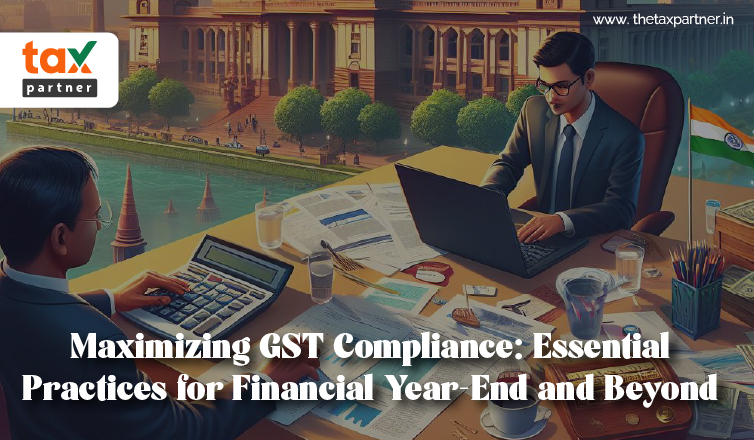GST Compliance: Essential Year-End Practices and New Financial Year Strategies
Essential Year-End Practices and New Financial Year Strategies for Maximizing GST Compliance
Author- Tanvi Thapliyal
As the financial year comes to an end and a new one starts, businesses that operate under the Goods and Services Tax (GST) regime need to get ready for different compliance tasks and strategic initiatives. It is important to optimise GST compliance not just to meet regulatory requirements, but also to ensure that operations run smoothly and finances are managed wisely. In this article, we will explore key activities that businesses should undertake at the year-end and the start of the new financial year to take care of the complexities of GST effectively and capitalize on opportunities for growth.
Compliances To Take Care of Before the End of Current Financial Year & Beginning of New Financial Year
Invoice Related Compliance
Invoice-related tasks play a crucial role in maintaining compliance for businesses under GST. As we approach the end of the financial year, there are a few important tasks to keep in mind when it comes to invoices:
-
Make sure that all invoices are in compliance with the GST laws and regulations. It's important to include certain information when dealing with GST (Goods and Services Tax). This information includes the GSTIN (Goods and Services Tax Identification Number) of both the recipient and supplier, their addresses, the place of supply, and the breakdown of the GST amount.
-
Make sure to include the appropriate HSN (Harmonised System of Nomenclature) or SAC (Services Accounting Code) codes on your invoices. If your total sales in the previous financial year amount to less than Rs. 5 crores, you need to provide a 4-digit HSN code. If your turnover exceeds Rs. 5 crores, you should use a 6-digit HSN code.
Businesses can avoid penalties and keep their operations running smoothly under the GST regime by making sure they comply with these invoice-related tasks.
E- Invoice Related Compliances
It is important for businesses with a total turnover of more than Rs. 5 crores in the previous financial year to comply with e-invoicing regulations.
-
If your business has an aggregate turnover of more than Rs. 5 crores, it is important to make sure that you comply with the mandatory e-invoicing requirements. E-invoicing is a system that the government requires businesses to use for creating invoices. It helps make the process more efficient and consistent by using digital technology.
-
Make sure that your e-invoices follow all the e-invoicing regulations set by the GST authorities. When creating an invoice, make sure to include important information like the GSTIN of the recipient and supplier, invoice number, date, and any other required fields mentioned in the e-invoicing guidelines.
Businesses can benefit from using digital invoicing to improve efficiency, accuracy, and compliance with GST laws by making sure they comply with e-invoicing regulations.
Documentation for supplies
It's really important to have documentation for supplies that you receive from people who aren't registered. This is especially important to make sure you're following the reverse charge mechanism (RCM) regulations.
-
Prepare self-invoices for all supplies that you have received from individuals or businesses that are not registered. When creating a self-invoice, make sure to include important information like the supplier's details, recipient's details, description of goods or services, quantity, value, applicable taxes, and any other relevant information.
-
Issue payment vouchers for all payments made to unregistered vendors, regardless of whether they are registered under GST or not. Payment vouchers should include important information like the date of payment, the amount paid, the method of payment, and details about the transaction.
Businesses can reduce compliance risks related to RCM and ensure they follow GST regulations by carefully recording supplies received from unregistered individuals.
Opting for the Composition Scheme
If you are eligible and thinking about opting for the Composition Scheme under GST, here is what you need to do:
Review of the GST Registration Certificate
-
Make sure to check if all the new business places have been correctly incorporated into the GST registration certificate. see that the information for these new places, such as addresses and other important details, is accurately represented.
Businesses can ensure compliance with regulatory requirements and maintain accurate records of their business locations by conducting a thorough review and making any necessary updates or amendments to the GST registration certificate.
Ensuring Compliance with GST Returns and Books of Accounts
-
It is important to compare the sales turnover, credit notes, and output tax recorded in the books of accounts with the GST returns filed (GSTR-1 & GSTR-3B) for the previous year in order to properly match them. It's important to make sure any differences are resolved and keep a record of the reasons for future audits or assessments.
-
Resolve the Input Tax Credit (ITC) by comparing the ITC recorded in your books of accounts with the ITC claimed in GSTR-3B. Ensure that they match with the information downloaded from the GST portal in GSTR-2B. make sure that you match the GSTR-2B with the ITC claimed in GSTR-3B and in your books of accounts by 30th November of the following year. This will help you identify any missed or excess ITC claims that need to be addressed.
-
Confirm with suppliers who have filed GSTR-1 but not GSTR-3B, or vice versa, to make sure that the Input Tax Credit (ITC) you are claiming won't be disallowed Remember to keep all the emails and other communication you have with suppliers. This is important in case you need to review or evaluate them later on.
-
Review the ineligible and blocked Input Tax Credit (ITC) in your books of accounts and make sure that there are no unintentional claims in your GST returns. Reverse any ITC claims that are ineligible or blocked.
-
Review any liability under reverse charge in your books of accounts. Double-check that it is accurately reflected in your GSTR-3B and make timely payments, including the appropriate interest.
-
If there are any instances where output tax liability or credit notes were missed in GSTR-1 & GSTR-3B, they need to be corrected by either 30th November of the following year or the due date of filing the Annual Return, whichever comes earlier.
-
Make sure to review and pay vendors within 180 days from the date of the invoice to avoid any reversal of Input Tax Credit (ITC). After making the payment, you can reclaim the Input Tax Credit (ITC) without any time limit.
-
Make sure to pay GST on any other income and sale of assets, if it applies to you. If there are any outstanding amounts, pay them along with the interest to stay compliant.
Additional compliance measures
-
If you're a registered exporter and you want to export goods or services without paying IGST, you'll need to apply for the renewal of your LUT (Letter of Undertaking) at the end of the financial year for the next fiscal year (2023-24). This will ensure that your export activities can continue smoothly.
-
It is important to file GST refund applications on time. Make sure to submit any eligible refund application within the specified timeframe of 2 years, as required by GST laws, to avoid losing out on refund claims
-
If you have a registered business with a total turnover of more than Rs. 5 crores, you need to file Form ITC-04 every six months. If your turnover is up to Rs. 5 crores, you need to file your taxes annually. Ensuring compliance with this requirement will help ensure that inputs and capital goods sent are accurately reported.
-
Make sure to comply with record keeping by maintaining all accounts, documents, and records as required under GST laws. Keeping proper records makes it easier to conduct audits, assessments, and ensure compliance with GST regulations.
Conclusion
As the financial year comes to a close, it's really important for businesses to make GST compliance a top priority. This will help them avoid penalties and keep their operations running smoothly. Each step, from reconciling sales turnover and input tax credit to reviewing liabilities under reverse charge and filing necessary returns, plays a crucial role in upholding regulatory standards.
It's also important to stay informed about important deadlines, like renewing your LUT, applying for GST refunds, and filing ITC-04. This will help you avoid any issues with your export activities and make sure you get your refunds on time.
We, at TaxPartner, are here to help businesses at every step of their journey towards GST compliance. Our team of experts is here to provide you with comprehensive support in understanding and complying with the complex GST regulations. We can help you navigate through the process, conduct thorough reconciliations, and ensure that all the necessary filings are completed accurately and submitted on time. TaxPartner is here to support you in understanding and meeting GST compliance requirements. With our help, you can feel confident in managing these complexities and dedicate your attention to advancing your business.
TaxPartner is here to be your trusted partner in GST compliance, helping you succeed in a regulatory landscape that is constantly changing.
FAQ’S
What is GST?
GST stands for Goods and Services Tax, which is an indirect tax levied on the supply of goods and services in India. It has replaced multiple indirect taxes previously levied by the central and state governments.
Who needs to register for GST?
Any business or individual involved in the supply of goods or services with an aggregate turnover exceeding the threshold limit specified by the GST law needs to register for GST.
What are the different types of GST?
There are three types of GST: CGST (Central Goods and Services Tax), SGST (State Goods and Services Tax), and IGST (Integrated Goods and Services Tax). CGST and SGST are levied on intra-state supplies, while IGST is levied on inter-state supplies.
What is input tax credit (ITC)?
Input tax credit allows businesses to claim credit for the GST paid on inputs (purchases) against the GST liability on output (sales). It helps avoid the cascading effect of taxes and reduces the overall tax burden.
How often do I need to file GST returns?
GST returns need to be filed monthly, quarterly, or annually, depending on the type of taxpayer and their turnover. Regular taxpayers usually file monthly returns (GSTR-3B) along with an annual return (GSTR-9).
What happens if I miss the GST return filing deadline?
Missing the GST return filing deadline can lead to penalties and late fees. It's important to file returns within the specified due dates to avoid such consequences.
Can I claim GST refund?
Yes, eligible taxpayers can claim GST refund for excess input tax credit, accumulated due to inverted duty structure, exports, or other specified reasons. The refund process involves filing a refund application with supporting documents.
What is e-invoicing under GST?
E-invoicing is a system for electronically generating and reporting invoices in a standardized format. It aims to improve tax compliance, reduce tax evasion, and enhance the efficiency of the invoicing process.
Do I need to maintain records and documents for GST compliance?
Yes, registered taxpayers are required to maintain various records and documents, including invoices, account books, tax invoices, credit and debit notes, and other relevant documents, as specified under the GST laws.
How can TaxPartner assist with GST compliance?
TaxPartner offers comprehensive support for GST compliance, including registration assistance, return filing, reconciliation, advisory services, audit support, and representation before tax authorities. Our expert team ensures timely and accurate compliance with GST regulations, allowing businesses to focus on their core operations.
What is the composition scheme under GST?
The composition scheme is a simplified scheme available for small businesses with a turnover below the prescribed threshold. Eligible taxpayers can opt for the composition scheme and pay GST at a fixed rate based on their turnover, without the need for detailed invoicing and compliance requirements.
Can I revise my GST returns after filing?
Yes, GST returns can be revised within a specified time frame, typically before the due date of filing the next return for the same tax period. However, it's important to ensure accuracy and consistency in filing revised returns to avoid discrepancies.
Are there any exemptions or concessions under GST?
Yes, GST law provides for certain exemptions, concessions, and reduced rates of tax for specific goods, services, and categories of taxpayers. These exemptions and concessions are subject to conditions and criteria prescribed under the law.
What is the GST rate structure for different goods and services?
GST rates vary depending on the type of goods or services supplied. They are categorized into multiple tax slabs, including 0%, 5%, 12%, 18%, and 28%, with certain goods and services attracting additional cesses.
How can I verify the GSTIN of my suppliers or customers?
You can verify the GST identification number (GSTIN) of your suppliers or customers using the GST portal's "Search Taxpayer" feature. Simply enter the GSTIN or other details to verify the authenticity of the registration.



